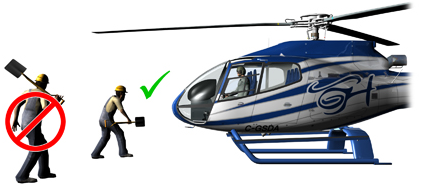Safety Considerations
Security around the helicopter
Contribute to the success of the flight
- Support the decisions of the pilot safety.
- Please consider:
- How to embark and disembark.
- In-flight and ground procedures.
- Location of safety and survival equipment.
- Emergency procedures.
Deliver flñight information
- Inform about your flight requirements.
- Coordinate all aspects you think are important to consider for the flight.
- Resolve your doubts with crew.
- Ask about information you request and that has not been delivered.
On ground
Security Zone
- Dress according to the weather
- Inform the pilot about:
- The weight of your luggage
- Health problems
- High sick resistance
- Do not smoke around or inside the helicopter.
- Stay away from the landing area for the landing or takeoff
- Make sure your clothes and cover your head against the wind produced by the rotor
- Protect your eyes from dust or particles lifted by rotor
- Keep landing area clear
- Wait for the instructions to approach or abandonment the helicopter
- Go to and left the helicopter from the side - in a crouching position - never from behind.

- If you can, wait until the rotors stop.
- Move at the descending side of the aircraft, leaving space to the rotor.
- Carry load firmly on one side of your body, never on your shoulders or head.

- Never drop elements to or from the helicopter.
- Secure load carefully and firmly to prevent its movement.
- Verify cargo compartment door is closed and secure.
- Have a reservation of special medications that you require in the event of delays on the route
On the Helicopter
- Use the safety belt (and ties of shoulder, if available) while flight.
- Use flight helmet or head headset if available.
- Stay in your seat if not authorized to move.
- Do not distract the pilot during takeoff or landing.
- Read the instructions for operation of doors, emergency exits and location of the ELT (emergency locator transmitter) and emergency equipment.
During Emergency
- Follow instructions given during safety briefing.
- Do not distract crew
- Check that the loose items in the cabin are locked.
- Remove your glasses and keep them in a Pocket (might need them later).
- Assume the position of impact, in accordance with the taught
- Adjust seat belt with shoulder ties, adjust them and sit in an upright position, knees together, arms folded on his chest.
- Without shoulder ties, bending the body forward so chest rest on the thighs, head on his knees, arms tied tightly under the thighs.
After an emergency landing
- Wait for instructions to evacuate, or until the rotor stops.
- Assist others to evacuate well away from the aircraft.
- Remove the kit first aid and other emergency teams after verifying the risk of fire.
- Manage or cooperate with first aid if required.
- Remove the ELT, please read the instructions and activate it.
- Set up a camp to be the most comfortable as you can.
- Build your camp as more protected from the wind.
- Stay close to the aircraft - not from venturing outside the workplace.
Always remember that help is on its wayOn flights over water:
- Listen carefully for the induction of the pilot before the flight over water.
- Use vest life and/or immersion suit.
- Learn the procedures of mounting, adjustment and seat belt release.
- Know the location and operation of emergency exits and doors.
- Know the location and operation of the ELT.
- Follow instructions of immersion that the pilot gives you.
- Remove tie, release collar.
- Assume the position of impact when the pilot gives the instruction.
- Wait for instructions for the abandonment, or until the rotor stops.
- After a dive
- Establish a reference position.
- Release the seat belt.
- Inflate the vest and raft when it is out of the helicopter.
FOR YOUR SAFETY AND ALL, REQUIRE THESE RECOMMENDATIONS
INTEGRATED MANAGEMENT AND SAFETY SYSTEM
DISCOVERY AIR INNOVATIONS CHILE LTDA.


